Autumn Leaves: A versatile carbon source
Leaves have multiple uses for the composter. While green summer leaves are usually added to the compost bin the large quantities of leaves resulting from the autumn fall lend themselves to a number of different uses. In addition to being used as a composting “brown” which can be kept dry and saved for use during the winter months autumn leaves can be used as a mulch, in a layer when lasagne composting, as worm bedding, and to make leaf mould.
Autumn Leaves that have turned brown and fallen to the ground provide an excellent source of carbon having lost most of their nitrogen and should be mixed, or layered, with a Green material high nitrogen e.g. manure, grass clippings, or food scraps.
As “Browns” high in carbon, with a C/N ratio averaging at about 60 but ranging from 20-100 if they are to be composted, they will need to be accompanied by a good source of nitrogen to maintain the C:N the balance in the bin. Some sources recommended collecting the leaves as soon as they start falling, and their cells are still hydrated and their nitrogen content is higher making decomposition easier, but most wait for all the leaves to fall so that they only sweep up once or twice.
Leaves tend to be slow to compost but shredding the leaves will accelerate their decomposition. This can be done using a leaf shredder or scattering them on the lawn and mowing with a rotary lawn mower. The amount of lignin, calcium and nitrogen in the leaves will also affect the time it takes for them to breakdown. In general, as leaves take a long time to compost and tend to mat, this may result in some anaerobic decomposition unless they are regularly aerated.
Guidance by local councils in the UK used to suggested that leaves, as they are slow to compost, be used to make leafmolld rather than in compost. suggesting cardboard and paper as the main source of carbon in urban "household" composting. In the US leaves seem to be regarded as one of the main source of browns. I use autumn leaves in my pallet composters on the Allotment community site and have found that they compost easily and within the time scale I use.
Composting leaves
As a rule, leaves being used for composting or making leafmold should be shredded this exposes a greater surface area, reduces the risk of the leaves matting and reduces the bulk of the leaves making composting easier and reduces the risk matting.
Mixing the leaves with grass or another good source of nitrogen will speed decomposition. If a shredder is not available two processes can be combined by spreading the leaves of the lawn and mowing them
To cold compost leaves in a dalek type bin , use 50-70% (by volume) leaves and 30-50% of high nitrogen ensuring the carbon rich leaves are well mixed with the nitrogen rich food scraps, vegetable leaves, grass etc. and other materials in the bin.
If hot composting leaves, the compost bin should be at least one cubic meter (3 cubic feet) to break retain the heat and help the leaves decompose more quickly. When using leaves when hot composting I follow a 6-8” layer of leaves with a 1-2” layer of manure as two of the brown and green layers when constructing a bin using alternat layers of green and browns. Others suggest using thinner layers of leaves. Some add a layer of soil between the leaves and manure. If manure is not available another nitrogen rich layer may be used such as dried blood, or bone meal.
An alternative method is to make a normal layered compost pile using layers of 4-5 parts leaves to one-part green garden or kitchen waste. The material is initially mixed and aerated 1-2 times a week. Additional greens can be added when the contents are turned to prolong the active stage and maintain the temperature.
Alicia Bodine in a Home Guide by Demand Media recommends the following composting method which uses pine needles. Starting with an empty compost bin fill approximately 8 inches grass clippings, or any other green waste from plants in the garden. Water until moist but not sopping wet. Add a 3-inch layer of pine needles, repeat the watering, and then add a 1-inch layer of horse, cow, or chicken manure. Water again. This layering of grass, pine needles and manure is repeated until the bin is full. The bin should be watered to keep it moist and the compost mixed to aerate it once every two weeks. The compost should be ready for use in about two to four months.
Hot composting using a Hotbin composter provides a quick and effective means of composting shredded Leylandii and pine needles producing compost in about 3 months if the temperature is maintained. One of the advantages of leaves is that they can be stored and Hotbin suggests that they can be added to the bin with grass cuttings in a in a 50/50 mix. The high temperature of the decomposing nitrogen rich grass will speed the decomposition of the leaves.
All leaves are not the same and the type of leaf available may influence the choice of whether they are used to make leafmould or compost.
Ash, cherry, linden, maple, popular and willow are categorised as “good leaves” by Ken Thompson in "Compost" composting down in about a year being relatively low in lignin and relatively high in nitrogen and calcium. He classifies beech, birch, oak, and sweet chestnut as bad leaves being higher in lignin and lower in nitrogen and calcium and taking at least two years to compost.
Holly In addition to the lignin content another problem with holly leaves is that the waxy coating on the leaves provides a protective outer layer preventing water loss which makes it important to shred these leaves and to only compost them in small amounts spread across several bins if possible. However, as it can still take up to two years to compost holly so it is best to use a dedicated bin.
When large amounts of Cherry laurel are shredded a smell of smell of almonds or marzipan, can sometimes be detected and concern has been expressed about the risk of cyanide poisoning. The safety precautions are not complicated i.e., chipping, or shredding it in a well-ventilated area and not standing downwind while working.
Grass/Leaf Sandwich
An alternative to adding the leaves to a compost bin is to make a leaf/grass sandwich using alternative layers of grass and leaves as if you were Grass Boarding substituting the leaves for the cardboard that would be used in a grass board heap. A variation on this technique is to use a mower to shred the leaves on the lawn when the grass need cutting so that there are about equal quantities of grass and shredded leaves.
Compost made using Pine needles is acidic and as consequence their compost is recommended for acid-loving plants such as strawberries, raspberries, and rhododendrons. However, the leaves take longer to decompose than most other types so should be composted separately. I would always recommend shredding them first.
If you only have space for one compost bin pine needles can mixed with the normal compostable waste but I would recommend that they do not exceed 10 percent of the content. However, the composting leaves in a conventional heap or bin can be a slow process.
Shredding and urine accelerator
Shredding the leaves using a garden vacuum, which includes a shredder, will reduce the size of the leaves and speed up the composting process. An alternative means of shredding is to spread the leaves on the lawn and mow them (and the grass). This provides a carbon (leaves) and nitrogen (grass) mix which further reduces the time taken to compost.
Grass can also be added to the leaves shredded using the garden vacuum to speed up the decomposition. Some people mix in grass from a cut in the spring toboost the over-wintered leaves
Urine makes an effective accelerator and can be applied directly by men or fo more discretely collected indoors and taken to the bin or bag.
Leafmould Choice of Leaves
With leafmould it is necessary to make use of the leaves that are available and if necessary, to adjust the procedure to obtain the best result. All leaves, including conifer needles, will eventually breakdown but some will do so more quickly than others and should be treated separately. Small quantities of the more awkward ones such as holly and other evergreens are best shredded and added to the compost bin. Although I save some autumn leaves to be added to the compost heap during the winter as a source of browns faced with a large number of autumn leaves, I would recommend making leafmould rather than compost but keeping the holly and evergreens separate from deciduous leaves.
Traditionally leafmould was made by piling the leaves in a heap and keeping it sufficiently wet to prevent them blowing all over the garden, or by imprisoning them within a wire netting cage. However, we can now bag them or use a bin.
Different leaves breakdown more slowly than others but no less an authority than the RHS makes it clear that all leaves including conifer needles will eventually break down into leafmould.
The RHS divides leaves into the following groups.
- Oak, beech and hornbeam, break down easily to produce good quality leafmould. Leafmould made from oak and beech is good for use on acid loving plants.
- Thicker leaves such as horse and sweet chestnut, sycamore and walnut, are slower to break down and benefit from being shredded before being used to make leafmould. These should also be shredded if they are to be composted.
- Evergreens such as holly, Aucuba and cherry laurel, are better shredded and composted.
- Conifer needles are slow to breakdown taking two to three years to decay but this can be reduced to a few months using a technique described below. Conifer hedge clippings are better used shredded and added to the compost heap than used for making leafmould.
NB Beech, birch, oak are classified as being slower to breakdown by other sources (see below)
Some leaves such as acacia, camphor, California bay laurel, cypress, Eucalyptus, Juniper, pittsporum and walnut contain acids that are toxic to other plants and are best avoided. However, it is said that they can be added if they only form a small proportion a small of the total.
I would recommend gathering conifer needles separately as they produce an acidic product which is ideal for mulching ericaceous plants, such as rhododendrons, azaleas, camellias, Pieris and blueberries.
With pine trees, the peak time for leaf drop will probably be the spring but they can be can collected throughout the year.
Making Leafmould
We are using different methods of making leafmould at the Demonstration site including wire cages, plastic bins and bags. We are also using mixed leaves and bags of leaves from single trees for comparison as well as a mixture of leaves from the lawn and grass from the final cut of the year.
While a pile of leaves left in the corner of the garden will eventually be broken down by fungi to form leafmould but in dry windy weather a considerable proportion of them will be spread across the garden by the wind. To avoid this situation the leaves have traditionally been contained in a wire netting cage or wooden compost bin.
As with composting larger bins work best so try to make the container at least metre square. Simply fix the chicken wire to four posts with galvanised fencing staples available from any builder’s merchants or DIY store. If there is a good supply of leaves opt for a three-bin system so that the leaves from different years and stages of decomposition can be kept apart. The bottom of the bin can be lined with weed suppressant or cardboard. Second-hand builders' bulk bags can also be used to make leafmould they are permeable allowing excess moisture to drain away. Some people support the corners of the bag with stakes. The bag will be very heavy when filled so some cut the bottom out so that it can be lifted off the leafmould when it is ready others regard the bag as disposable and cut the front open to harvest the leafmould. The lids will help retain moisture in dry weather and prevent the contents becoming waterlogged during wet periods.
For best results the pile should be checked during hot or dry periods and watered if necessary, to keep leaves damp so that the moisture content high enough, as with all bin composting turning the contents occasionally to aerate it will also help.
Plastic “cages” are also available, but the simplest form of plastic container is a large plastic sack. A plastic refuse sack or old compost bags is filled with leaves and compressed. The leaves should be watered but not soaked. The bag is tied and stabbed several times with a garden fork. It is then left in a corner of the garden for 6 – 12 month . checking periodically that the contents are still wet.
Coffee grounds as an additive for leafmould
One of the reasons that we normally make leafmould separately from compost is that the leaves are a Brown being high in carbon. It is possible to speed up the decompostition process by adding,
nitrogen rich, grass using the technique of shreddding the leaves by mowing them on the lawn which will speed up decomposition of the leaves.
An altenative method of speeding up the process is, if you have access to a local coffee shop, restaurant or cafe, to add used coffee grounds to the leaves. Coffee grounds contain about 1.45% nitrogen making them a useful Green which can also be added to wormeries and the compost bin.
Many coffee chains now bag and give away used grounds to composters. While some outlets might limit the number of bags each composter can take it is quite likley that an arrangement can be reached to have a regular bulk supply and a local independant outlet may be happy to have a source that will to take their whole supply.
Comfrey enriched Leafmould
Comfrey can be used to make leafmould with additional nutrients.
Comfrey is added to two year old leafmould two or three months before the nutrient enriched leafmould is to be used. This requires the leafmould to be transfered to a new container with a layer of comfrey leaves added every 10cm/4inches. Although it requires some effort it produces a relative consistant product.
An easier method is to mix comfrey with the leaves as the leafmould bag or container is being filled in the autumn.
Composting leaves using lime
Composting leaves in a bin with the addition of lime and fertiliser is said to provide a relatively quick method of producing a leaf compost.
A layer leaves approximately 200mm (about 8”) deep is put in the bottom of a 1-1.5-metre-high compost bin. Water is added to moisten the leaves while being careful not to make them so wet that they form a mat. A mixture of equal parts lime and lawn fertiliser (20g) is then sprinkled over the leaves. Take care not to exceed the quantity of lime. The lawn fertilizer must not include an herbicide (selective weed killer). This is covered by a 1” layer of garden soil. The alternating layers are continued until the bin is full moistening each layer of leaves as they are added.
To speed decomposition the heap should be aerated by turning every two weeks (a two-bin system makes this easier). The bin is kept covered to prevent waterlogging but water if the composting leaves dry out. The moisture content should be checked each time the material is turned at intervals through out the process.
This section is based on an artical by Ann Wolters at https://www.ehow.com/how_7571536_quickly-compost-leaves-lime.html
Horse Chestnut Leaf Miner
The Horse chestnut leaf miner (Cameraria ohridella) is an exotic insect pest that lives in horse chestnut trees. The larvae (caterpillars) mine within the leaves. Although it can cause severe damage to horse chestnut leaves on an annual basis, and discolouration and defoliation before normal autumn leaf-fall. The pest does not significantly impair trees' health, and they will usually flush normally the following spring. The Forestry Commission recommended treatment consists of removing fallen leaves during the autumn and winter and either send them to be commercialy composted, or hot composting at home. This will destroy the over-wintering pupae.
Cool composting (or making leafmould) is less effective control measure when leaves are collected into smaller heaps and not turned regularly, as the temperature will not reach the level necessary to kill the pupae. However covering the leaves with a 10cm layer of soil or 15-30cm layer of other plant material until the end of May, will prevent adult emergence in the spring and will help to reduce damage. Bagging the leaves for two years when making leafmould then covering the bag with a layer of soil and not opening the bag until after May of the second year should be even more effective.
Bokashi leaf compost
There is a variation on making leaf mould using plastic sacks this involves adding the contents of the Bokashi bin to the plastic leaf mould sack containing dry leaves during the winter months. This is reported to produce leaf compost during the coming spring and summer. I have not tried this but further details are on Jenny`s Bokashi Blog.
https://bokashiworld.wordpress.com/2011/11/01/autumn-leaves-make-great-pumpkins/
Collect autumn leaf fall into old plastic compost sacks or bags as normal but do not soak the leaves as would normally be the case if leaf mould is being made .The use of dry leaves in the Bokashi leave composting system is said to avoid the bags smelling during the composting process.. Seal the bags with a tie or clip which can be released and resealed during the following months. During the winter open the bags and add the contents of the Bokashi bins as they become available. If the leaves in the bag are damp, add newspaper or shredded paper to absorb the moisture
During the spring, the sacks should be moved to a sunny part of the garden or be moved to the greenhouse so that the warmth will encourage activity of the microbes in the Bokashi and the original autumn leaves. The
This will produce a mulch for use early in the season or a more useful compost mix after a later in the summer. At this stage, the bags can be stabbed with a fork to create air holes and entry points for worms. These holes will also provide drainage.
Ash Dieback leaves
At present most of the outbreaks of ash dieback disease in Britain are in East Anglia and Kent, although a small number of outlying cases have been confirmed in northeast England and Scotland. The common ash (Fraxinus excelsior) is the most frequently affected species but Fraxinus angustifolia is also highly susceptible. This information and advice is taken from the Forestry Commission (http://www.forestry.gov.uk/pdf/FCPH-ADD.pdf/$FILE/FCPH-ADD.pdf).
The leaves typically show wilting and black-brownish discoloration that extends into the midrib and leaf stalk.
Where leaves affected by the disease require disposal, the preferred way to reduce the rate of spread of the infection is by using on-site disposal options and not move the leaves to another. In addition, gardeners should not collect dead leaf litter from elsewhere. Spores can be transmitted via infected dead leaves and this could infect new areas. Local authorities should advise householders not to put out green waste suspected of being affected by Chalara, but to deal with it within the grounds of their own premises, in all but exceptional cases.
Depending on the nature and location of any infected leaves the following options are suggested by the Forestry Commission in decreasing
order of preference.
(a) Burning on site on the ground or incinerators brought t where allowed under legislation on smoke control areas.
(b) Burial in the ground by local authorities would constitute a landfill operation and requires an environmental permit which fulfils the requirements of the Landfill Directive. However, individuals acting in a private capacity are not subject to the same requirements so householders may bury affected leaves within the grounds of their premises if they wish.
(c) Composting on site. There is no clear scientific evidence available on the effectiveness of composting as a treatment.
Composting is less effective when leaves are collected into smaller heaps and gardens, because temperatures in small heaps are too low to kill spores. Hot Composting should be effective.
If cold composting covering the leaves with a 10cm layer of soil or 15-30cm layer of other plant material, and leaving the heaps undisturbed for a year (other than covering with more material) is likely to prevent any spore dispersal. Bagging and leaving for two years to make leafmould should be even better. Any leaves which are not destroyed or otherwise processed (e.g. through composting) can be used for mulching or on allotments only in areas where the disease is already present. Given the uncertainties mentioned above, wherever possible any resulting compost should be spread on or near the infected source and not passed on to third parties who might move it off site.
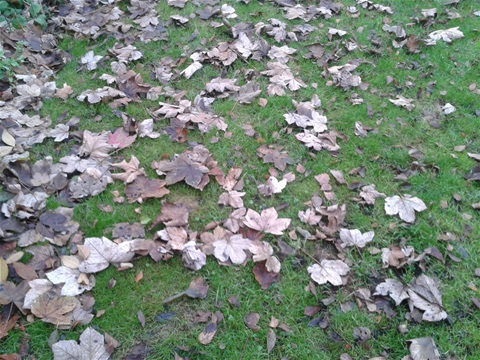
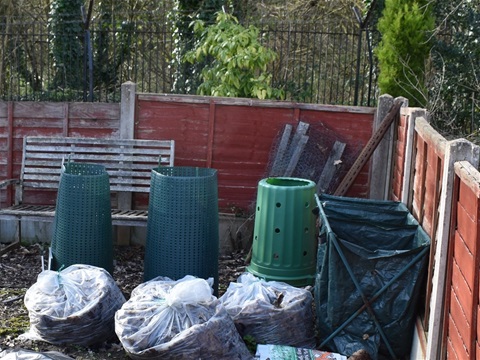
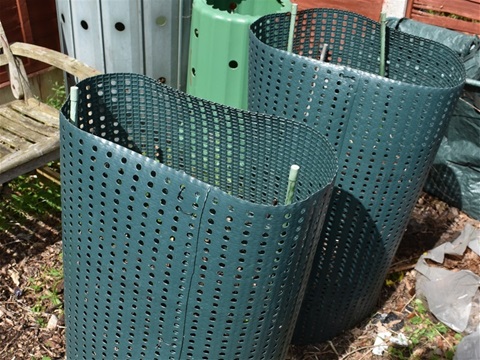
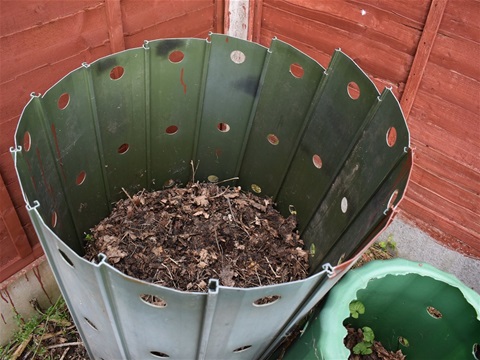

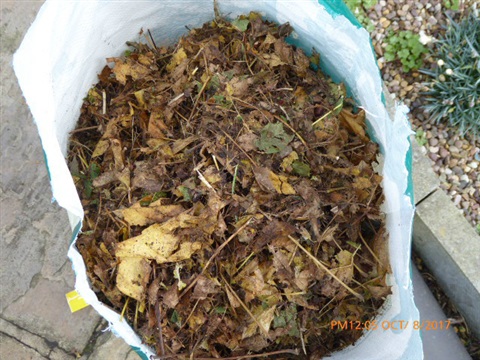
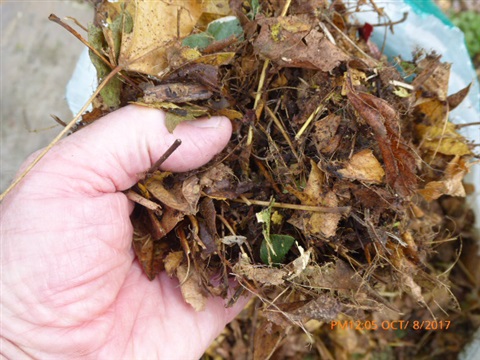
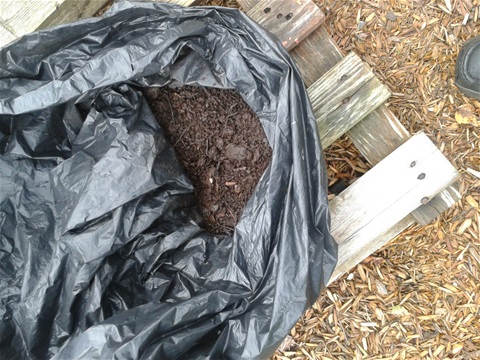
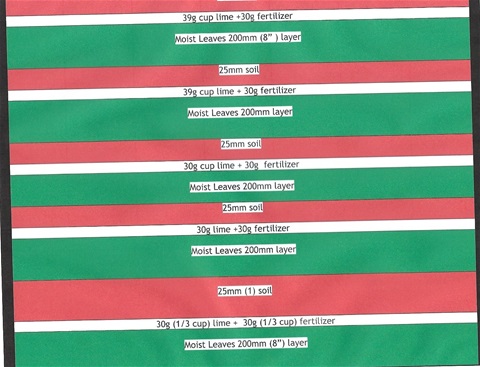
Geoff Bennett
Old builders bags make good leaf mould containers (the type you get sand/aggregate in) they are classed as lifting tackle and have to be certified so most merchants don't want them back
Wendy
I have 5 plastic storage boxes with shredded beech leaves, am using urine once a month, they do get matted and I give them a good turning. Is this ok for leaf mould or should I spread them out more?
Pauline Thorpe
Our horse chestnut has been diseased for about 6 years, leaf miner we think, must we continue to dispose of the leaves?
Janey Kidd
Does the bag for composting leaves have to be black?
Rod
We can see no reason why the bag should be black, other than the fact that many waste bags are black. We are now using a clear bag on our site.
Brendan Fahy
An excellent site re info on composting leaves